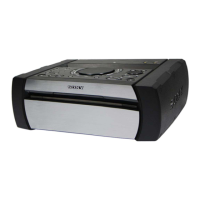
Do you have a question about the Sony HCD-SHAKE10 and is the answer not in the manual?
| Type | Mini Hi-Fi System |
|---|---|
| Power Output | 100 W |
| Number of Channels | 2.1 |
| Amplifier | Integrated |
| Equalizer | Yes |
| Tuner | FM |
| CD Player | Yes |
| USB | Yes |
| Bluetooth | Yes |
| NFC | Yes |
| Display | LED |
| Frequency Response | 20 Hz - 20 kHz |
| Input Sensitivity | 500 mV |
| Functions | CD, USB, Bluetooth |
| Audio Input | RCA |
| Dimensions | 290 x 330 x 250 mm |
Guidelines for using unleaded solder, including temperature and handling precautions.
Safety cautions, handling of optical pick-up, and laser diode emission checks.
Details on identifying different model numbers and their corresponding part numbers.
Step-by-step guide outlining the sequence for disassembling the unit.
Instructions for removing top, side panels, and other external sections.
Detailed steps for removing specific boards like 2CH DAMP, 4CH DAMP, and regulators.
Procedure for removing the CD/DVD mechanism and the front panel assembly.
Important notes on correctly installing flexible flat cables to prevent damage.
Procedure to test buttons, knobs, and screen display panel segments and LEDs.
Methods to display software version, model, and destination information.
Instructions for performing User Reset and Cold Reset to restore factory settings.
Procedures for Disc Tray Lock release, Bluetooth history clear, and Shop Front Demo.
Procedure to check FM signal reception and automatic scanning performance.
Method to check the optical pick-up's focus bias using an oscilloscope.
Flowchart for diagnosing the Switching Regulator (SSN-172AD and SSN-171AD) output voltages.
Step-by-step diagnosis for troubleshooting optical block issues, including laser diode and RF signal.
Procedure for confirming MOSFET resistance values on the 2CH and 4CH DAMP boards.
Diagram showing the physical placement of various circuit boards within the unit.
Schematic illustrating the signal flow for the RS Servo, USB, and HDMI sections.
Functional block diagram of the main processing and audio circuits.
Diagram showing the power amplifier stages and associated components.
Schematic of power supply and panel control signals.
Layout of components on the Motherboard (Component Side) for reference.
Component layout for the 2CH DAMP board, both component and conductor sides.
Component layout for the TOP PANEL board, showing connections to other boards.
Detailed schematic for the MIC board, showing circuit connections for microphone inputs.
Component layout for the LED DRIVER board, detailing LED control circuitry.
Exploded diagram showing the assembly of side panels and the top panel.
Exploded view detailing the disassembly of 2CH and 4CH DAMP boards and associated parts.
Diagram illustrating the removal and assembly of the back panel sections.
Exploded view of the motherboard assembly, showing its connection to other components.
Diagram showing the disassembly and reassembly of the front panel and its modules.
Exploded view of the main chassis, including regulator and AC inlet components.
Detailed exploded view of the top panel assembly, including knobs and encoders.
Exploded diagram of the CD/DVD mechanism, showing loading assembly and optical device.
List of semiconductors including transistors, diodes, and ICs with part numbers.
Listing of passive components like capacitors, inductors, resistors, and connectors.
Details on tactile switches, rotary encoders, ferrite beads, and other miscellaneous parts.
Chronological record of changes and updates made to the service manual.
Instructions on how to efficiently locate signal paths and contact points in diagrams.
